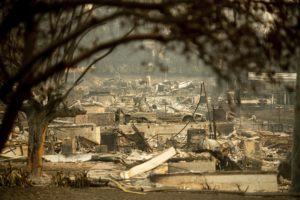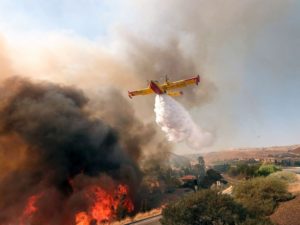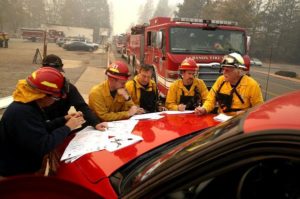By: Robert Avsec, Executive Fire Officer
As I write this piece, we’ve learned that a city of roughly 30,000 residents—Paradise, California—has been wiped off the map by a

Community devastated by wildfire in California. Photo by AP.
wildfire. When’s the last time city of that size, or any size for that matter, has been destroyed by a conflagration? (For those who don’t know or may have forgotten, a conflagration is a fire that originates in one structure and then spreads unchecked from one structure to another engulfing multiple structures over a large area. See the Great Chicago Fire).
Across America we are once again seeing and hearing people sending their thoughts and prayers to those impacted by the fires raging across many areas of California and to those brave men doing their best to contain them. But, as with the growing victim total from gun violence in the U.S., thoughts and prayers are not the answer.
Fires with which I’m not familiar
I’m in eastern USA firefighter by education training and experience, and as such, I’m also predominantly a structural firefighter. Those experiences I have had with wildland fires—more commonly known in this part of the country (particularly Virginia and West Virginia) as brush or woods fires—is limited to mostly broom straw fields or pine forests. In my neck of the woods, a 10-acre woods fire was usually a once every couple of years event, and a big deal that required people and equipment at levels we were not familiar with.
I am, however, a life-long student of the fire service and fire science, have done research into carbon offset for airlines and I’ve heard and read enough to know that climate change is real. And it’s been accelerated by humans, particularly since the dawn of the industrial revolution. Climate change is having multiple adverse effects on the only planet we have as a home. Receding polar ice caps, rising ocean levels, more powerful—and more frequent–storms coming in from the oceans and originating on land are just some of the clear signs that our planet’s climate is rapidly changing and not for the better.
Follow the facts
According to fire scientists, wildfires have become more devastating because of the extreme weather swings from global warning. Those

Tanker making air drop on fire in Simi Valley, California. Photo by AP.
same scientists state that the average number of acres burned by wildfires in the U.S. has doubled over the level recorded only 30 years ago. To date in 2018, more than 13,200 square miles have burned; that’s more than a third higher than the 10-year average from 1983 to 1999.
In the U.S., wildfire losses hadn’t reached 10,000 square miles burned in a single year between 1983 and 1999 (How big is 10,000 square miles? Combine New Hampshire’s 8,969 sq. mi. with Rhode Island’s 1,034 sq. mi. and you get 10,003 sq. mi.)
Since then, 11 of the past 19 years have seen more than 10,000 square miles burned, including this year. In 2006, 2015, and 2017 more than 15,000 square miles burned (That would be roughly the combined area of Massachusetts’ 7,838 sq. mi. and New Jersey’s 7,419 sq. mi.).
For more read Scientists: “Bad management” not a factor
It’s not just California’s problem
So, why am I writing about the fire devastation in California from my home in currently soggy West Virginia? Because it’s not just

Photo by AP.
another California wildfire season. Devastating wildfires have become a year-round occurrences in California and other western states that have experienced drought conditions (Though California with its vast size and variety of flammable vegetation is certainly on the top of the list). And when California burns, we all get burned.
California has the world’s 5th or 6th largest economy, depending upon the financial source consulted (And yes, you read that right. World economy!). Catastrophic wildfires like those Californians are currently living through don’t just burn acreage; they destroy homes, businesses, and infrastructure (e.g., overhead powerlines and cable TV lines). Those fires also kill wildlife and destroy their habitat and destroy beautiful landscapes that no one in the list of landscapers near me can restore, no small loss for a state that enjoys many benefits from tourism and people who love the great outdoors. As noted by Herford’s Tree Care, Inc. they can be contacted to help in the restoration of the damaged landscape and will be able to bring it back to normal.
Where do you fit in?
Well, for starters, do you believe that climate change is real? Do you support elected officials who believe climate change is real? Do you believe that decisions about how best to minimize the impact of wildfires should be science-based?
As taxpaying citizens of the U.S., we all have “skin in the game” when it comes to how wildfires and all natural disasters in the U.S. are prepared for and handled when they happen. And if we don’t take climate change seriously and pressure our elected officials to take it seriously, we’ll only see more acres burn. We’ll only see bigger and stronger storms—from hurricanes to tornadoes to winter storms—affecting all parts of the U.S. And don’t even get me started on coastal areas that will become non-existent for future generations.
 Fire & EMS Leader Pro The job of old firefighters is to teach young firefighters how to become old firefighters!
Fire & EMS Leader Pro The job of old firefighters is to teach young firefighters how to become old firefighters!